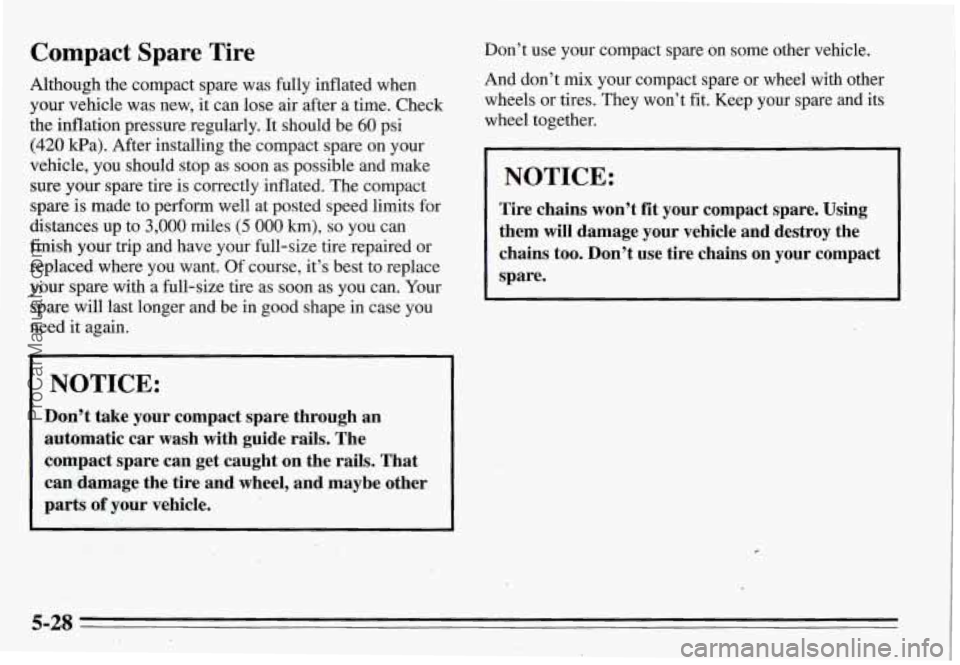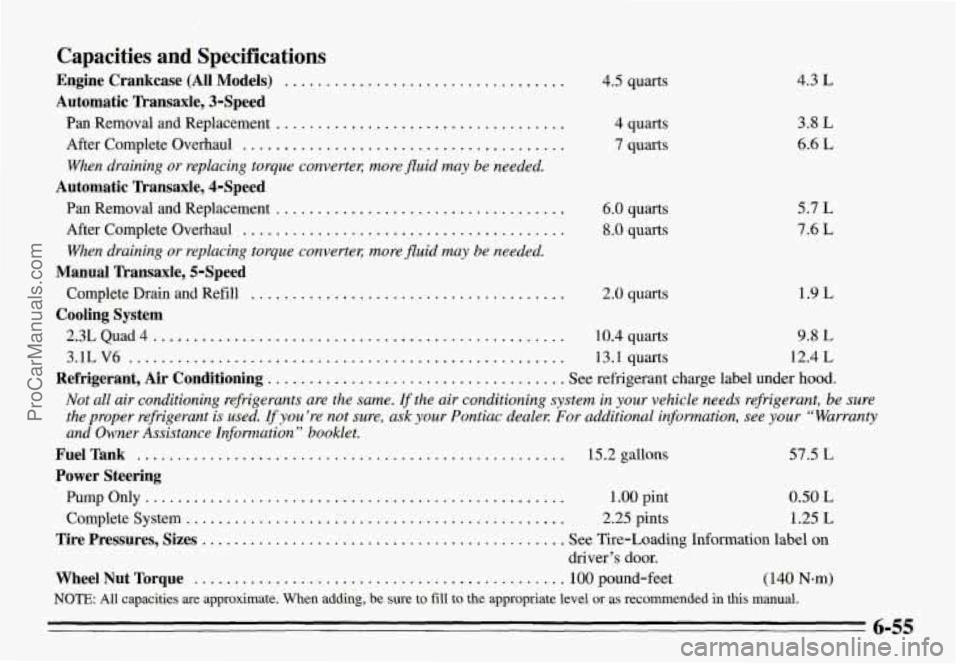Page 171 of 354

Towing your Vehicle from the Rear Loading Your Vehicle
8
I NOTICE:
Do not tow your Pontiac from the rear, or your
vehicle could be badly damaged and the costly
repairs would not be covered by your warranty.
TIRE-LOADING INFORMATION
VEHICLE CAP. WT.
FRT. CTR. RR. TOTAL LBS.
MAX. LOADING 23 GVWR SAME AS VEHICLE
CAPACITY WEIGHT
XXX COLD TIRE
TIRE SIZE SPEED PRESSURE
RTG PSI/KPa
FRT.
RR.
SPA.
IF TIRES ARE HOT, ADD 4PS1128KPa
SEE OWNER'S MANUAL FOR ADDITIONAL
INFORMATION
Two labels on your vehicle show how much weight it
may properly
carry. The Tire-Loading Information label
found on the rear edge of the driver's door tells
you the
proper size, speed rating and recommended inflation
pressures for the tires on your vehicle.
It also gives you
important information about the number
of people that
can be in
your vehicle and the total weight that you can
carry. This weight is called the Vehicle Capacity Weight
and includes the weight of all occupants, cargo, and all
nonfactory-installed options.
4-28
ProCarManuals.com
Page 209 of 354

Compact Spare Tire
Although the compact spare was fully inflated when
your vehicle was new, it can lose air after a time. Check
the inflation pressure regularly. It should be
60 psi
(420 Wa). After installing the compact spare on your
vehicle, you should stop as soon as possible and make
sure your spare tire is correctly inflated. The compact
spare is made to perform well at posted speed limits for
distances up to
3,000 miles (5 000 km), so you can
finish your trip and have your full-size tire repaired or
replaced where you want. Of course, it’s best to replace
your spare with a full-size tire as soon as you can. Your
spare will last longer and be in good shape in case you
need it again.
I NOTICE:
Don’t take your compact spare through an
automatic car wash with guide rails. The
compact spare can get caught on the rails. That
can damage the tire and wheel, and maybe other
parts of your vehicle.
Don’t use your compact spare on some other vehicle.
And don’t mix your compact spare or wheel with other
wheels or tires. They won’t fit. Keep your spare and its
wheel together.
NOTICE:
Tire chains won’t fit your compact spare. Using
them
will damage your vehicle and destroy the
chains too. Don’t use tire chains on your compact
spare.
5-28
ProCarManuals.com
Page 249 of 354

When it’s Time for New Tires
One way to tell when it’s
time for new tires is
to
check the treadwear
indicators, which will appear when your tires have
only
1/16 inch (1.6 mm) or
less of tread remaining.
You need a new tire if
0 You can see the indicators at three or more places
around the tire.
0 YOU can see cord or fabric showing through the tire’s
rubber.
The tread or sidewall is cracked, cut or snagged deep
enough to show cord or fabric.
The tire has a bump, bulge or split.
The tire has a puncture, cut, or other damage that
can’t be repaired well because of the size or location
of the damage.
Buying New Tires
To find out what kind and size of tires you need, look at
the Tire-Loading Information label.
The tires installed on your vehicle when it was new had
a Tire Performance Criteria Specification (TPC Spec)
number on each tire’s sidewall. When you get new tires,
get ones with that same TPC Spec number. That way,
your vehicle will continue to have tires that are designed
to give proper endurance, handling, speed rating,
traction, ride and other things during normal service on your vehicle. If your tires have an all-season tread
design, the TPC number will be followed by an
“MS”
(for mud and snow).
If you ever replace your tires with those not having a
TPC Spec number, make sure they are the same size,
load range, speed rating and construction type (bias,
bias-belted or radial) as your original tires.
6-38
ProCarManuals.com
Page 266 of 354

Capacities and Specifications
Engine Crankcase (All Models) ..................................
Automatic Transaxle, 3-Speed
Pan Removal and Replacement ...................................
When draining or replacing torque convertel; more fluid may be needed.
Pan Removal and Replacement ...................................
When draining or replacing torque convertel; more fluid may be needed.
After Complete Overhaul .......................................
Automatic Transaxle, 4-Speed
After Complete Overhaul .......................................
Manual Transaxle, 5-Speed
Cooling System
Complete Drain and Refill ......................................
2.3LQuad4 ..................................................
3.1LV6 .....................................................
4.5 quarts
4 quarts
7 quarts
6.0 quarts
8.0 quarts
2.0 quarts
4.3 L
3.8 L
6.6 L
5.7 L
7.6 L
1.9 L
10.4 quarts 9.8 L
13.1 quarts 12.4 L
Refrigerant, Air Conditioning .................................... See refrigerant charge label under hood.
Not all air conditioning refrigerants are the same. If the air conditioning system in your vehicle needs refrigerant, be sure
the proper refi-igerant is used.
If you’re not sure, ask your Pontiac dealel: For additional information, see your “Warranty
and Owner Assistance Information
” booklet.
FuelTank .................................................... 15.2gallons 57.5 L
Power Steering
Pumponly ................................................... 1.00 pint 0.50 L
Complete System .............................................. 2.25 pints 1.25 L
Tire Pressures, Sizes ............................................ See Tire-Loading Information label on
driver’s door.
WheelNutTorque ............................................. 100pound-feet (140 N-m)
NOTE: All capacities are approximate. When adding, be sure to fill to the appropriate level or as recommended in this manual.
6-55
ProCarManuals.com